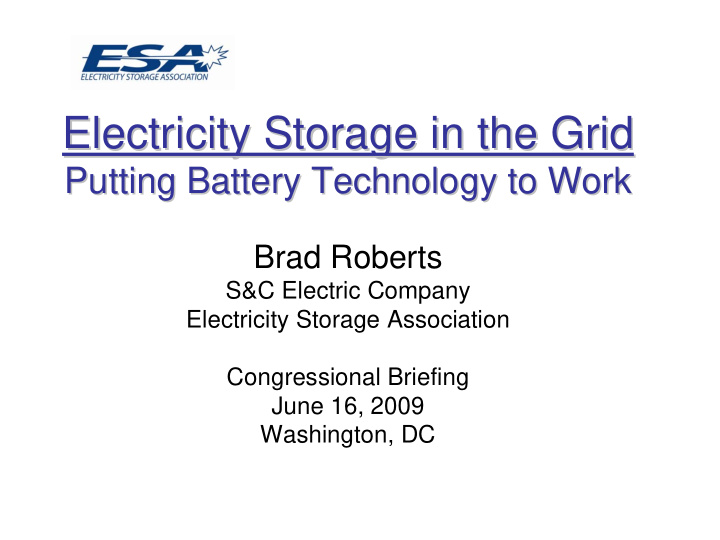



Electricity Storage in the Grid Electricity Storage in the Grid Putting Battery Technology to Work Putting Battery Technology to Work Brad Roberts S&C Electric Company Electricity Storage Association Congressional Briefing June 16, 2009 Washington, DC
Distributed Energy Storage in the Distributed Energy Storage in the Grid Grid • What does it mean • Expanding battery technologies � High temperature � Nickel-cadmium � Lithium-ion � Carbon lead acid • Where are we today • What’s needed in the future
What is Distributed Energy Storage What is Distributed Energy Storage • Smaller storage devices up to 50 MWs • Storage systems connected throughout the grid � Utility substations � Wind and solar farms � Community energy storage � Residential • Eventually will involve PHEVs & EVs
High Temperature Batteries High Temperature Batteries
World’ ’s Largest Battery s Largest Battery World (34 MW, 6 hours) (34 MW, 6 hours)
Nickel- -Cadmium Ni Cadmium Ni- -Cd Cd Nickel Largest battery in the US grid (26 MW)
Flow Battery - ZnBr Powercell’s 100 kW, 1h battery 3 phase, 480 V 23
Zinc Flow Battery Zinc Flow Battery
Lithium - Ion Battery Started in early 90’s 50% of Small Portable Market Scaling Up Issues 1- Cost 2- Construction 3- Safety Concerns - High Power & Energy Density - Long Cycle Life - Efficient - Mature (since 1992) - High Manufacturing Cost - Special Charging Circuit (safety) - Difficult to scale up 33
Lithium- -Ion Battery Storage System Ion Battery Storage System Lithium
Carbon Lead Carbon Lead Carbon lead is a hybrid energy-storage device, which combines an asymmetric supercapacitor and a lead-acid battery in one unit cell, without extra electronic control. – + – Separator + PbO 2 Carbon PbO 2 electrode Pb Asymmetric supercapacitor Lead–acid cell i – + i 1 Pb i i 2 UltraBattery Carbon electrode
Where are we Today Where are we Today • Global battery activities • Awareness of storage need growing • DOE Electricity Advisory Committee Activities • Significant battery investment in the current stimulus bill
Global Battery Activities Global Battery Activities • Lead Acid � Large production still present in the US • High Temperature Sodium � NaS production in Japan increasing to over 100 MWs per year � GE building $100M sodium metal halide plant in upstate New York � Sodium nickel chloride production in Europe • Lithium-Ion � China and South Korea dominate consumer product production � Japan heavily funding PHEV development � Fastest growth sector for US to support PHEV and utility application
2 0 0 9 National Electricity 2 0 0 9 National Electricity Delivery Forum Delivery Forum Infrastructure Modernization Options in an Uncertain Economy What Will be the Most Transformative Technology for the Electricity Industry? 1. Renewables and low-carbon generation tech. 2. Transmission superhighways 3. Energy storage technologies, inc. PHEVs 4. An integrated Smart Grid 5. Demand resources that reduce newbuilds
2 0 0 9 National Electricity 2 0 0 9 National Electricity Delivery Forum Delivery Forum Infrastructure Modernization Options in an Uncertain Economy What Will be the Most Transformative Technology for the Electricity Industry? 15% 1. Renewables and low-carbon generation tech. 2. Transmission superhighways 19% 3. Energy storage technologies, inc. PHEVs 38% 4. An integrated Smart Grid 26% 5. Demand resources that reduce newbuilds 3%
Key Recommendations Key Recommendations of EAC Storage Report of EAC Storage Report • Fulfill mandates of Energy Independence and Security Act of 2007 – Research & Development Efforts – Applied Research and Demonstration Activities – Near, Mid and Long-term Goals • Create Financial Incentives for installing Storage • Use Storage for Ancillary Services • Add Storage as a component of integrated T & D and renewable portfolio standards • Guide policy makers and regulators to include storage in rate bases • Communicate improved awareness of storage benefits to the grid
ARRA Energy Storage Funding ARRA Energy Storage Funding Amounts Amounts • Approximately $210 for energy storage • 12 – 19 Estimated number of Energy Storage Awards � 1-2 Battery Storage Utility Load Shifting/Windfarms - $40M to $50M total � 1-2 Frequency Regulation Ancillary Services - $40M to $50M total � 4-5 Distributed Energy Storage for Grid Support - $25M total � 1-4 Compressed Air Energy Storage - $50M to $60M total � 5-6 Demonstration of Promising Energy Storage Technologies - $25M total
Key Issues for Storage in the Future Key Issues for Storage in the Future Economic • Cost of storage – Need volume & competition – Incentives to industry • Being able to capture multiple values in a given utility application • How to handle cost recovery of Regulatory multiple benefits across distribution, transmission and generation? • How to handle energy in and out in a deregulated environment?
Recommend
More recommend